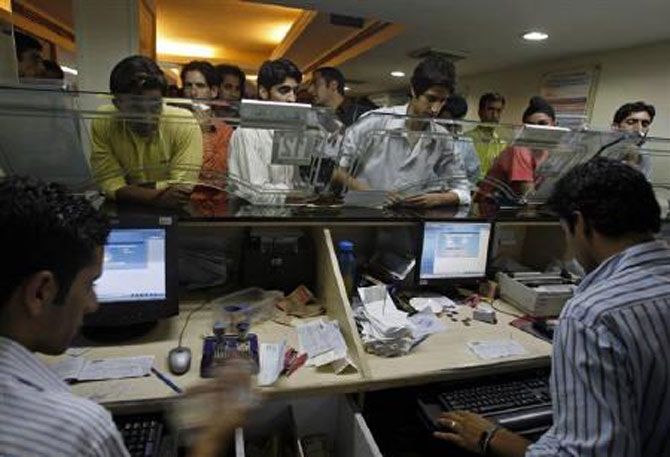As many as 10 public sector banks could be out of the infusion plan because of Sebi's minimum public shareholding norms.
 The government’s well-intentioned plan to help public sector banks (PSBs) make a fresh start could face roadblocks created by its own past rules.
The government’s well-intentioned plan to help public sector banks (PSBs) make a fresh start could face roadblocks created by its own past rules.
Replenishing lost capital is necessary, but it comes with several constraints, says a report by proxy advisory firm Institutional Investor Advisory services (IiAS).
According to the Indradhanush scheme, banks need Rs 1.8 lakh crore in the next four years to become well-capitalised, of which the budgetary allocation for support is only Rs 70,000 crore. Banks will need to raise the remaining Rs 1.1 lakh crore from the market by 2018-19.
Of the promised Rs 70,000 crore, the government had already infused Rs 20,000 crore into PSBs by December 31, 2015.
Therefore, it will infuse only an incremental Rs 50,000 crore in PSBs till 2018-19.
The two major constraints flagged by IiAS are the government’s insistence on maintaining a 50 per cent equity in PSBs and the Securities and Exchange Board of India’s requirement of the government reducing its stake in PSBs to 75 per cent or less by August 2017.
The the government needs to ensure that its stake does not increase beyond 75 per cent post the capital infusion, and if banks raise capital from the market, the government’s share cannot be diluted below 50 per cent.
 “Regulations require the government to reduce its stake in listed banks to 75 per cent or less by August 2017. This results in seven PSBs being automatically excluded from the incremental Rs 50,000 crore infusion, and another three where the infusion will have to be limited, unless these banks are able to dilute the government shareholding by raising a large amount of capital from the market,” the report said.
“Regulations require the government to reduce its stake in listed banks to 75 per cent or less by August 2017. This results in seven PSBs being automatically excluded from the incremental Rs 50,000 crore infusion, and another three where the infusion will have to be limited, unless these banks are able to dilute the government shareholding by raising a large amount of capital from the market,” the report said.
Therefore, the proposed capital infusion under the Indhradhanush scheme will directly benefit only 11 of the 21 listed PSBs.
Another constraint comes for the possible dilution of the government’s stake to less than 51 per cent, should banks raise the required Rs 1.1 lakh crore from the market in the next four years.
On March 2, 2016, the market capitalisation of PSBs aggregated Rs 2.85 lakh crore, but the free float market cap was only Rs 99,000 crore.
Of this, the State Bank of India group accounts for more than half. “How realistic is it to expect banks to raise Rs 1.1 lakh crore in equity capital from the market? Even if the public sector banks raised the capital, it would significantly dilute the government’s stake (to below 51 per cent in some cases), unless valuations improve substantially,” IiAS said.
The tepid market interest in these shares due to their stressed balance sheets, the report added, "For valuations to improve substantially, PSBs will first need to demonstrate performance, and improved risk management practices that will temper future deterioration in asset quality."
An analysis of data compiled by the BS Research Bureau showed while the total market cap of PSBs stood at Rs 2.92 lakh crore on Wednesday, the combined value of stakes in excess of the 51 per cent limit in all these banks came to around Rs 39,000 crore.
This is just about 35 per cent of the Rs 1.1 lakh crore targeted under the Indradanush scheme.
Rising government control
The government has increased its control over PSBs over the past five years. State-owned insurer Life Insurance Corporation of India (LIC) has also played a key role. This defeats the very purpose of listing these because minority shareholders do not have any say, argues IiAS.
According to the report, the median government stake in PSBs increased to 69.24 per cent on December 31, 2015, from 59.42 per cent on March 31, 2010. In fact, the government has also used LIC as a secondary tool for capital support. LIC’s median equity stake in PSBs increased to 11.18 per cent on December 31, 2015, from 8.69 per cent on March 31, 2010. “In effect, government control (government and LIC) over PSBs has increased to a median 80 per cent on December 31, 2015, which defeats the purpose of listing PSBs,” IiAS said.
IiAS estimated that LIC had infused over Rs 12,000 crore in financial support to PSBs in the past three years, and is expected to infuse more capital in the current year. "While the government and the Reserve Bank of India are saying the right things--that only banks that perform will get capital--LIC continues to be a surrogate, which possibly creates a contagion risk," the advisory firm said.










